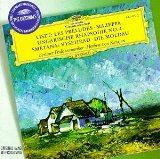Les Preludes - Liszt's Beautiful Symphonic Poem
Franz Liszt's glowing Les Preludes is a grand, free-flowing symphonic poem...
One of the composer's earliest tone poems, it's by far his most popular. It's a dazzling, beautiful, free-flowing piece, the flagship for Liszt's daring style of "new music".
While it's not one of my favorite of Liszt's orchestral works (which would probably be the Faust Symphony), I still really like the beautiful textures and the smooth way which Liszt develops the whole piece from a simple melody.
Let's take a look at the piece...
'Les Histoires'
The origins of Les Prelude are a bit misty. It looks like it started life in a piece for male chorus and two pianos which Liszt wrote while he was traveling through France, Spain and Portugal in 1844.
The words were based on a poem by a French poet Liszt met in Marseille. Liszt then wrote 3 other choruses based on other poems by this same poet.
Later on he orchestrated the poems (or should I say, someone else did it for him...).
He then had a flash of inspiration: why not stick a big overture in front of them?? He sketched it out, and then his Swiss assistant Joachim Raff orchestrated it for him (Liszt wasn't that experienced with orchestras).
Liszt conducted the premiere of the piece in Weimar in February 1854.

The full title of the piece is Les preludes (after Lamartine) referring to a poem by Alphonse de Lamartine. But this was just a fanciful idea that Liszt had.
The dramatic piece of text at the beginning of the score isn't by Lamartine - Liszt himself wrote it! It starts:
"What else is our life but a series of preludes to that unknown Hymn, the first and solemn note of which is intoned by Death?"
What a cheerful thought!
Quite a few people over the years have wondered if the title "Les Preludes" could mean anything else. One idea, which Liszt himself hinted at, is that the piece is a prelude to a new way of writing music.
Les Preludes was actually the first of Liszt's tone poems to be performed - so it was the start of a completely new style of orchestral piece.
'Le Musique'
The piece is typically Lisztian - powerful, dreamlike, Romantic, and always changing.Liszt wanted to breathe new life into his art, and create more elaborate and expressive music than anyone else had done before. He invented the idea of the symphonic poem to allow him to do this.
A symphonic poem (or tone poem) is a one-movement orchestral piece, based on the idea of an overture (which paints images and characters in listerner's minds). But Liszt, like a typical Romantic, expanded it, adding a touch of his own magical genius.
One technique which Liszt was really good at was called thematic transformation. This is where he took a simple melody and used it over and over and over again by changing the rhythm, the notes, the speed, or the way it's played. Les preludes has a great example of this with the main theme:
You hear it at the very beginning of the piece (although it's only hinted at there). Liszt uses it all the way through the tone poem, playing with it and making it sound different. First in a quiet but confident way:
Then, after a stormy middle section, Liszt uses the theme to evoke dreamy images of clearing skies and flowers (at least that's my interpretation)...
Finally, at the end of the piece, the melody becomes a triumphant march!
Another Liszt piece which heavily uses thematic transformation is the Sonata in B Minor.
The piece is actually very well crafted and has lots of beautiful and intelligent techniques. I'd say it was the perfect example of Liszt's orchestral work.
Les Preludes and all other other symphonic poems Liszt wrote (Dante Symphony, Faust Symphony, etc.) were difficult for audiences to understand. They needed more concentration and thought. So naturally a lot of people didn't like them!
It was the start of the War of the Romantics against composers like Brahms, who liked to be traditional.
Les... Recordings
Many recordings of this Liszt music poem don't capture the full power and glory of the piece. One good one I recommend is conducted by Herbert von Karajan with the Berlin Philharmonic, on Deutsche Grammophon, which also includes the tone poem Mazeppa and an orchestral version of the 2nd Hungarian Rhapsody.
This recording is somewhat standard, but captures the spirit of the powerful, direct style of music that Liszt is famous for.
Another great recording is the one conducted by Sir George Solti with the Chicago Symphony orchestra. This was a live recording, and has a fantastic energy and electricity to it. The recording of "Les Preludes" is powerful, but not so much that it gets out of control. Rather, Solti perfectly handles the tempo, and stops the performance becoming too brash like a lot of others.
One more recording to consider is Leonard Bernstein's 1960s outing with the NY Philharmonic, on Sony Classical. This is a wonderful little interpretation, full of keenness and sparkling brilliance.
I'll leave you with the symphonic poem in all its beauty, in these two wonderful videos... enjoy!
You might also like Liszt's Dante Symphony, a devilish orchestral depiction of hell, or his Faust Symphony, inspired by a German folk story.
If you like my site, please click "Like"... thanks!



